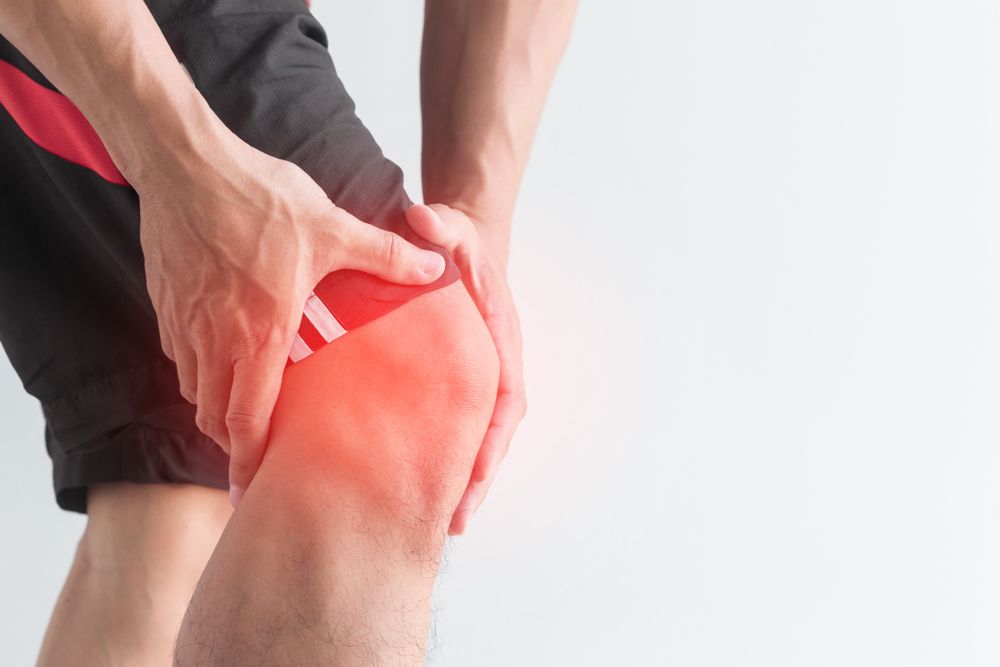Blog
Knee Pain when Squatting: Causes, Treatment and Prevention
The knee joint
The knee joint is one of the largest joints in the human body and is more complex than you may think!
This joint is comprised of the connection between the femur bone (thigh) and the tibia bone (shin) but also includes the patella bone (knee cap) that tracks over the front of the knee. These bones are held together by many muscles, tendons and ligaments. The articulating surfaces are covered by smooth, shock-absorbing cartilage including the meniscus.
It is easy to visualise the knee joint as a simple hinge, however, the movement of the knee is actually more complicated than this. During movement, the knee can flex-extend, through rolling and gliding movements of the bones, as well as a slight rotation to lock/unlock the knee at full extension.

Can squats cause knee pain?
The knee is designed to move and facilitate squatting as a movement. For most healthy people squatting should not cause knee pain. HOWEVER, knee pain when squatting is a common complaint, indicating some issue with the movement, or the knee joint itself.
Some common conditions that may cause knee pain when squatting include:
- Knee Osteoarthritis – A gradual breakdown of knee cartilage
- Tendinopathies – A maladaptive change in tendon connecting muscles around the knee
- Ligament sprains – A strain injury to any ligaments surrounding the knee, due to force, such as an impact or awkward twisting
- Tendon or muscle strains – A microscopic or larger tear in the tendon or muscle fibres due to overwork
- Cartilage or Meniscus Tears – Degenerative or traumatic injury to the cartilage under the kneecap or inside the knee
This may occur for various reasons, but none of the listed structural conditions are completely irreversible.
Most of these injuries can be directly caused, or contributed to, by poor technique or muscle patterns
Incorrect squatting technique
The correct technique when squatting is very important to prevent and treat pain. Any abnormality happens for a reason and in the knee, it is usually because of technique.
For individual assessment and knee pain treatment, it is recommended that you see a physio; however, there are some common issues to look out for.
- Patello-femoral pain syndrome – A very common issue for knee pain when squatting, is when there is some type of mal-tracking of the patella as the knee moves through its range. This is usually because of some muscle imbalance occurring in your quadriceps or often the hips. This may look like your knees collapsing inwards towards each other as you begin or end the squatting movement.
- Ilio-tibial band syndrome – Along the outside length of your thigh, a strong band of tissue runs from hip to the knee. When a person bends their knee, this band moves to support it. If this band becomes tight or rubs on the outer knee, it can become inflamed and cause pain. This can occur when the hip muscles, specifically the gluteal muscles don’t support the knee sufficiently.
- Limited Ankle Mobility – As you squat, you need to bring your knees forward to keep your centre of gravity over your feet, meaning you need to have flexible ankles. Without this mobility, there is no way to allow proper form and range of motion
Explore the Knee Pain We Treat
How to prevent knee pain while squatting
As mentioned, many of these structural or movement conditions are caused due to developed muscle imbalances, postural changes or lack of joint movement. The best knee pain when squatting treatment will include hands-on therapy to relieve pain and help alleviate tightness where appropriate. It will also include exercises for knee pain, that will progress to strengthen weaker muscles and create optimal muscle synchronisation and movement patterns, to achieve the perfect combination of rolling, sliding and twisting the knee performs every time you bend it!
How physiotherapy can help
Good knee physiotherapy can do so much to prevent knee pain and eliminate knee pain when squatting. The ideal session will incorporate a thorough assessment to identify deficits and the cause of the knee pain. This will lead to hands on treatment to reduce pain and loosen tight structures, and finally to prescribe the right exercises for knee pain. These exercises will depend on the individual weaknesses and affected structures for each patient.
Musculoskeletal Physiotherapy Australia
If you live in South East Queensland and are looking for an individualised, comprehensive assessment and treatment for your knee pain from squatting, go no further! Whether you need a knee physiotherapist on the Gold Coast, in Brisbane City, south Brisbane (Sunnybank Hills) or Sydney, we have expert clinicians who can give premium knee pain treatment and the perfect exercises for your knee pain.
Call us today, to find your squats physio!
